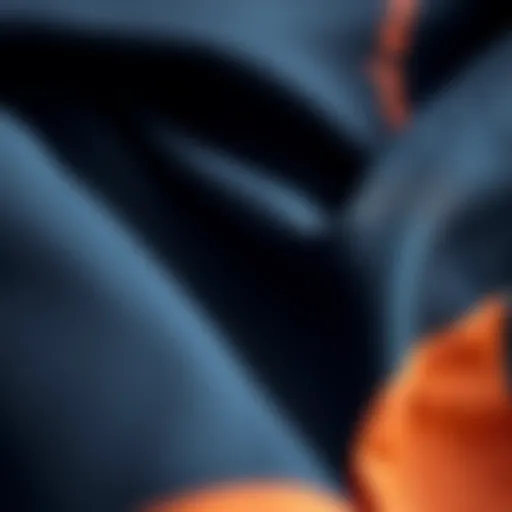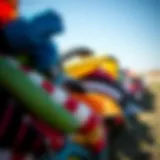Bindings and Boots in Kiteboarding: A Complete Guide
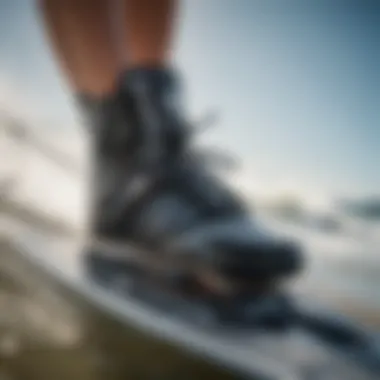

Intro
Kiteboarding stands out as one of the most thrilling water sports, combining elements of surfing, wakeboarding, and paragliding. One crucial aspect often swept under the rug is the role of bindings and boots. These components are not just afterthoughts but integral to a rider's experience, affecting both performance and comfort in ways many may not fully appreciate.
Understanding the different types of bindings and boots can make the difference between a joyful ride and a frustrating one. Newcomers to the sport might feel overwhelmed, yet with the right guidance, choosing suitable gear becomes an enjoyable part of the kiteboarding journey. Not all bindings and boots are created equal; various designs cater to specific kiteboarding styles, individual preferences, and even local conditions.
In this guide, we seek to unravel the complexities surrounding bindings and boots in kiteboarding. We’ll cover tips for selecting the right gear, delve into essential upkeep practices, and provide insights tailored for both beginners and seasoned riders. With this knowledge, you’re sure to enhance your times on the water.
Understanding Bindings and Boots
When it comes to kiteboarding, the gear you choose can make all the difference in your performance and overall enjoyment of the sport. Among the most crucial pieces of equipment are bindings and boots. They not only facilitate control over the board but also significantly affect stability and comfort during rides. Understanding how bindings and boots work, their respective designs, and their compatibility with various styles is paramount for any rider, whether you're a novice or a seasoned expert.
Bindings and boots can influence a rider's confidence and ability to perform tricks. They work together to provide a secure fit and enhance maneuverability. A mismatch in these components can lead to uncomfortable rides or, in the worst-case scenario, injury. Thus, understanding the nuances of bindings and boots should be a pivotal part of any kiteboarding enthusiast's education.
Key Elements to Consider:
- Control: Bindings are the connection between the rider and the board. Good bindings provide optimal support, allowing riders to exert control during turns and jumps.
- Comfort: Proper boots ensures comfort, which is essential for longer sessions on the water.
- Performance: The right combination of components directly translates to improved performance and riding style.
By focusing on the symbiotic relationship between bindings and boots, riders can make informed choices, leading to a more enjoyable and fulfilling kiteboarding experience.
The Importance of Bindings in Kiteboarding
Bindings serve as the pivotal link between the kiteboard and the rider. Their primary function is to secure the rider’s feet onto the board. A good set of bindings can transform an ordinary ride into an exhilarating experience. They allow the rider to exert control during maneuvers and maintain balance throughout the ride.
When you think about the role of bindings, consider this: a loose fit means potential slips and falls, which can spoil a session quicker than you can blink. On top of that, bad bindings can interfere with foot placement, making it tough to get comfortable or move freely. In contrast, high-quality bindings are designed to offer a snug fit while allowing subtle shifts in foot position, which is especially beneficial during challenging tricks or gusty conditions.
Choosing the right bindings isn’t just about preference. It involves consideration of riding style, weight, and even conditions you expect to face on the water. Once you get bindings that strike that sweet spot between snugness and flexibility, you'll notice the difference in both control and comfort while gliding on the water.
Boots: A Critical Component for Stability
Boots in kiteboarding provide critical support and stability. When you’re riding, it’s imperative that your feet are secured properly. This isn’t just about being comfortable; it’s about having a solid frame of reference for your maneuvers.
Different boot designs affect how you connect with your board. For instance, some boots come with a higher cut which offers additional ankle support. This feature can prove advantageous, especially for riders who love to push the envelope with high jumps or aggressive turns.
Conversely, lower-cut boots allow for better flexibility and a closer connection with the board. This flexibility can aid riders in performing intricate tricks but may sacrifice some ankle support. Finding a balance between these needs is vital:
- Higher-cut boots: Give stability and support.
- Lower-cut boots: Allow for more mobility.
Choosing the right style of boots involves evaluating what feels natural for you while considering your riding style and personal comfort. Stay conscious of how they complement your bindings; the combination should be conducive to enhanced stability and performance.
Types of Bindings
When it comes to kiteboarding, choosing the right bindings is not just a matter of preference; it can significantly impact your performance and safety on the water. Different types of bindings cater to various riding styles, conditions, and personal comfort, making this choice crucial for anyone serious about their sport. Understanding these bindings can help you strike the perfect balance between control, comfort, and responsiveness, whether you’re ripping through waves or soaring high into the sky.
Strap Bindings
Strap bindings are among the most popular options among kiteboarders, particularly those who are just starting out. These fixtures typically feature multiple straps that wrap around the foot, providing a snug yet adaptable fit. The design allows users to adjust the bindings quickly, accommodating different foot sizes and preferences.
One of the biggest advantages of strap bindings is their versatility. They can be used effectively across various styles of riding, from freestyle to freeride. The ease of entry and exit is another key selling point — just slip your foot in, tighten the straps, and you’re good to go. However, while they offer a good level of support, they may not provide the same level of control as other binding types, especially in high-speed situations.
Hard Shell Bindings
On the other end of the spectrum, hard shell bindings offer a much more rigid and locked-in feel. These bindings are constructed with a hard outer shell that encases the foot, providing maximum support while riding. The additional stiffness can improve control and responsiveness, making them particularly popular among expert kiteboarders and those who engage in aggressive riding styles.
Nevertheless, they are not without drawbacks. Hard shell bindings can feel restrictive to some, especially if they're not well-fitted. In fact, a poor fit can lead to discomfort or even injury during long sessions on the water. Therefore, it’s critical to pay attention to sizing and comfort when considering this option. Additionally, the weight of hard shell bindings might also be a consideration, as heavier gear can impact overall performance.
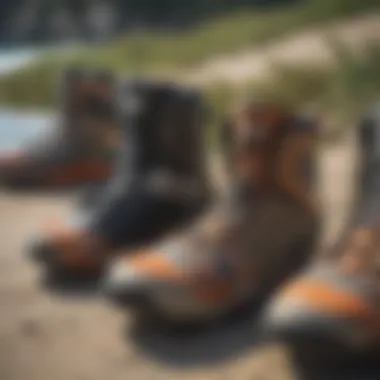

Hybrid Bindings
As the name suggests, hybrid bindings attempt to combine the best features of strap and hard shell types. They typically feature an adjustable strap system along with a rigid shell that provides the desired foot support. This dual approach allows riders to fine-tune comfort and performance, making hybrid bindings suitable for a wide array of riders.
The versatility of hybrid bindings cannot be overstated. They cater to riders who appreciate the comfort of strap bindings but also want the increased support offered by hard shell designs. This makes them ideal for those in transition between beginner and advanced levels. Still, as with any gear, the effectiveness of hybrid bindings ultimately depends on individual preference. Some riders may prefer the feel of one type over the other, making personal testing a priority before committing to a purchase.
"Bindings can sometimes feel like the unsung heroes of kiteboarding, but they play a crucial role in ensuring safety and performance on the water."
Consider this as you evaluate your options; the right choice can mean the difference between a glorious ride and a frustrating session in the waves.
Key Features of Quality Bindings
When it comes to kiteboarding, the choice of bindings can make or break a rider's experience. Quality bindings play a significant role in bridging the connection between the rider, the board, and the kite. Understanding the features that constitute quality bindings is essential not only for enhancing performance but also for ensuring safety out on the water. Riders looking for an edge in comfort and performance should pay attention to three core features: material durability, adjustability for optimal fit, and weight considerations.
Material Durability and Construction
The materials used in bindings are critical in terms of longevity and performance. High-quality bindings are often made from advanced plastics, composite materials, or even metal components that can withstand the harsh marine environment. A well-constructed binding endures both the strains of jumping and the wear of saltwater exposure, making durability non-negotiable.
Some bindings utilize materials like thermoplastic polyurethane (TPU) due to its resistance to abrasion and weathering. This material flexibility keeps them rigid under force while also offering necessary shock absorption; it’s a balancing act that can truly define a rider’s comfort. Consider bindings that incorporate reinforced stitching and multi-layered constructions—these are telltale signs of durability. Ultimately, opting for bindings that emphasize robust construction can mean the difference between a seamless ride and a catastrophic failure with each wave you encounter.
Adjustability for Optimal Fit
Having the perfect fit is more than just comfort; it can substantially affect control and technique. Quality bindings come with various adjustability features that should cater to different foot shapes and sizes. Look for bindings that offer multiple Velcro straps or ratchet systems designed to snugly secure the rider's feet, allowing for some level of customization.
For instance, some bindings incorporate micro-adjustments that let users fine-tune tightness, which can be especially beneficial during high-performance maneuvers. This capability not only enhances comfort but also maximizes board control, allowing for more precise navigation on the water. Without adequate adjustability, riders may struggle to maintain their stance, thereby impacting performance and potentially increasing the risk of injury.
Weight Considerations
The weight of bindings can influence how a kiteboarder performs in various conditions. Lightweight bindings help minimize resistance, aid in faster tricks, and contribute to an overall more agile experience. However, weight should not come at the cost of durability. A quality binding balances weight with strength, aiming for lightweight materials that don’t compromise performance.
Some of the latest designs feature lightweight constructions while maintaining robust support. Many riders favor bindings that weigh less than their counterparts, as they make jumping and maneuvering easier. A well-constructed lightweight binding aids in overall aerodynamics and responsiveness, ultimately translating to a more enjoyable ride.
"Selecting bindings that balance durability, adjustability, and weight will elevate both your comfort and performance on the water."
Before making a purchase, it's essential to consider how these key features align with your individual riding style and conditions. Examining these elements can drastically transform a kiteboarding session from merely good to truly exceptional.
Boots in Depth
When it comes to kiteboarding, boots can make or break your experience on the water. They serve as more than just a protective casing for your feet; they play a crucial role in stability, control, and ultimately your performance. Hence, understanding the nuances of boot design helps riders improve their skills and enjoy their time on the water.
Different Materials Used in Boots
The materials used in manufacturing boots are varied and each has its own unique characteristics. Generally, you'll find boots made from several types of materials:
- Neoprene: This is a common choice for kiteboarding boots. It’s flexible and provides a good level of warmth, which is especially useful for colder water conditions. Neoprene also offers a snug fit, which is crucial for controlling the board effectively.
- Rubber: Often used in the sole, rubber enhances grip and helps in maintaining traction when riding. It’s durable and resistant to wear, providing longevity.
- Synthetic Fabrics: These materials often combine durability with lightweight properties. Modern synthetics can mimic the flexibility of traditional materials but offer improved resistance to the elements. Riders facing various conditions, such as saltwater and UV rays, will benefit significantly from these options.
- Foam and Padding: Certain designs incorporate foam padding for added comfort. This can aid in reducing impact during jumps and tricks, ultimately enhancing the rider’s experience.
Impact of Boot Design on Performance
Boot design isn’t just about aesthetics; it's about functionality too. The shape, flex, and overall structure directly affect how a kiteboarder interacts with their gear.
A few important design considerations include:
- Flexibility: Some boots are designed with a stiffer build, while others allow for more flex. Stiff boots tend to provide better support, especially when landing hard jumps. In contrast, more flexible boots can enhance maneuverability and comfort.
- Fit: A snug fit is paramount. If a boot is too loose, it can lead to a lack of control, while one that is too tight can cause discomfort during extended sessions on the water. Riders need to find boots that mold comfortably to their feet.
- Ankle Support: Next, one must consider how much support the boot provides to the ankle. High-tops may offer better ankle stability, which is crucial for riders hitting choppy waters or attempting tricky maneuvers. However, some might prefer low-tops for increased foot movement and flexibility.
Ultimately, a rider’s performance can dramatically improve simply through careful attention to boot design. As skills develop, so do preferences, and the right entry point into the world of boots can set the foundation for a lifelong kiteboarding journey.
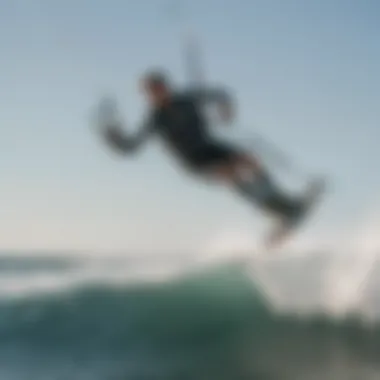

Choosing the Right Sole
The sole of a boot is another critical element that should not be overlooked. A strong, well-designed sole can have a huge impact on various factors such as grip, comfort, and responsiveness.
When selecting a sole, consider:
- Tread Pattern: Different tread patterns are available, and these can greatly influence how well the boot grips the board. A sole with good traction can help in executing maneuvers with more precision.
- Thickness: A thicker sole might provide more cushion but could compromise sensitivity and responsiveness. Finding the balance is essential for personal preferences and riding style.
- Material: Just as the upper materials matter, the sole’s material will also affect its performance. Rubber soles typically offer great grip and durability, while softer materials can provide comfort but may wear out faster.
Tip: Consider the type of kiteboarding you plan to do. For high-performance riding, you might lean towards a thinner, more responsive sole; for a casual day on the water, a thicker, more cushioned sole might be a better fit.
The importance of the boot selection process cannot be overstated. Riders with the right pair of boots that align well with their unique style and preferences are bound to experience an enhancement in their overall kiteboarding experience.
The Relationship Between Bindings and Boots
Bindings and boots are the unsung heroes of kiteboarding gear. Their interplay is not just a matter of fitting pieces together; it significantly influences how riders experience the water. Understanding this relationship is essential for anyone looking to elevate their kiteboarding game. Choosing the right binding and boot combo can enhance comfort, performance, and control, turning a good day on the water into a fantastic one.
Bindings serve as the direct connection between the rider and the board, while boots provide the crucial support and connection needed to control the kite and manipulate movements effectively. The quality of these components can deeply affect how a rider interacts with the wind and waves, which can be the difference between mastering new tricks or feeling like a fish out of water.
It’s all about synergy. Poor pairing might just lead to struggles, while finding the right match can lead to seamless rides.
Compatibility Issues
When it comes to compatibility, not all bindings and boots are created equal. Mismatched gear can lead to discomfort and inefficiency. For instance, a boot that’s too stiff might not work well with a flexible binding, resulting in a rigid feel that hampers maneuverability. On the flip side, a soft binding combined with a rigid boot may hinder the responsiveness that riders seek.
To ensure a harmonious mix, several factors need to be considered:
- Size and Fit: It’s vital to check if the boot size corresponds to the binding. Any gaps can cause instability, while a too-tight fit might restrict circulation.
- Flexibility: Riders should look at how flexible both the boot and binding are. Balanced flexibility ensures easier transitions and better performance in varied conditions.
- Connection Mechanisms: The method in which a boot attaches to a binding can vary. Different systems may either enhance or complicate the experience, particularly during quick adjustments.
Ensuring compatibility isn’t just about picking brands; it’s often about blending technologies and designs that work well together. Avoiding compatibility issues leads to an engaging ride, breaking the boundaries of what’s possible on the water.
Enhancing Performance Through Proper Pairing
Once you’ve navigated the compatibility challenges, the next step is optimizing performance. The right combination of bindings and boots can enhance everything from control and stability to comfort and energy efficiency.
Consider the following ways in which this optimal pairing can make or break a kiteboarder's experience:
- Improved Control: A well-matched binding and boot combo allows for precision steering. It’s like having a well-tuned machine; every movement translates efficiently,
- Better Energy Transfer: With proper alignment, the energy exerted through the feet is more directly transmitted to the board. This translates to quicker responses and smoother landings.
- Comfort Over Long Runs: Long sessions on the water can be tiring. A pair designed to work in harmony helps alleviate discomfort. Whether it's the right arch support or padding, it can mean hours of enjoyable riding instead of draining experiences.
In summary, the relationship between bindings and boots goes far beyond aesthetics. It’s about synergy, efficiency, and ultimately enhancing the kiteboarding experience. Every rider should critically assess their gear to harness the full potential of their setups, ensuring every wave caught is a great one.
Selecting the Right Gear
Choosing the right gear can make or break your kiteboarding experience. The synergy between bindings and boots determines not only your comfort but also your control on the water. From the moment you're strapped in, everything hinges on this relation. Opting for appropriate gear is pivotal in optimizing performance and ensuring safety.
When evaluating bindings and boots, several factors come into play that could significantly affect your ride. In essence, it’s about tailor-fitting the gear to your riding style and conditions. Whether you are gliding over flat water or tackling waves, the ideal gear offers not just performance, but also bolstered confidence.
Assessing Riding Style and Conditions
Understanding your riding style is fundamental to making the best choices. Are you a carefree cruiser, relishing in the gentle ebb and flow of the tide? Alternatively, do you thrive on adrenaline, jumping and performing tricks? Each style requires gear suited to its unique demands.
Moreover, environmental conditions cannot be brushed aside. Wind direction, intensity, and water conditions all play critical roles in how your gear performs. For instance, in choppy waters, a more rigid boot may enhance stability, but in calmer conditions, a more flexible option could augment maneuverability.
Some elements to consider when assessing your riding style and conditions include:
- Water Conditions: Flat, choppy, or wave ridden?
- Wind Conditions: Light, moderate, or strong winds?
- Skill Level: Novice, intermediate, or advanced?


Having an awareness of these factors will steer you in the direction of gear that ultimately aligns with your performance aspirations.
User Preferences and Feedback
User feedback often sheds light on what works and what doesn't. Kiteboarding is a personal endeavor, and riders frequently share insights based on their experiences. Online forums like Reddit provide platforms for open discussion and honest reviews, transforming anecdotal evidence into valuable lubrication for your decision-making process.
But feedback goes beyond forums. It's crucial to recognize that your preferences play a cutting-edge role in your selection process. For some, the fit is paramount; for others, it’s all about styling or equipment weight. The balance you strike needs to resonate with your riding goals and providing lasting comfort is a key consideration.
Some aspects of user preference to contemplate include:
- Fit: Does it feel snug but unrestrictive?
- Weight: Is lighter really better for your riding style?
- Flexibility: Do you prefer a stiffer feel or a more forgiving flex?
Ultimately, selecting bindings and boots isn't merely a technical decision; it's a reflection of personal preference intertwined with practical functionality. Listen closely to the whispers of the gear that calls out to you, and let those resonate with your kiteboarding spirit.
"The right gear is like a well-tailored suit; it enhances your strengths and works harmoniously with your style."
With the right foundations set, you can confidently venture into the world of kiteboarding, fully equipped for the challenges that lay in your path.
Maintenance of Bindings and Boots
Keeping your bindings and boots in tip-top shape is not just a good idea; it’s essential. Kiteboarding can be tough on gear, and maintaining these critical components goes a long way in ensuring safety, longevity, and optimal performance. Without proper maintenance, you might find yourself facing uncomfortable rides or worse—unexpected failures. A little routine care means you can ride the waves more confidently.
Cleaning Techniques for Longevity
To prolong the life of your bindings and boots, regular cleaning is a must. It’s all about being proactive rather than reactive, so here are some pointers:
- Rinse After Use: Whether you’re shredding on saltwater beaches or freshwater lakes, a good rinse with fresh water is vital. Salt and sand can be abrasive, wearing down the materials over time. Simply washing off your gear after each session can make a huge difference.
- Scrub Gently: For any stubborn grime, use a soft brush or cloth. Avoid harsh chemicals or stiff brushes that can scratch materials. You want to treat your gear with respect.
- Drying: Let your bindings and boots air out after rinsing. Avoid direct sunlight which can cause fractures or fading of colors. If they’re wet, don’t shove them in the bag immediately—this can trap moisture leading to mold or unpleasant odors.
"Regular maintenance is the key to enjoying uninterrupted kiteboarding sessions and ensuring your gear performs at its best."
Storage Recommendations
Storing your gear correctly is just as crucial as cleaning it. Here are some strategies to keep your bindings and boots in mint condition:
- Dry and Cool Place: Always store your gear in a cool, dry area. Humid or hot environments can warp bindings and degrade materials. Think of a closet or a designated rack away from heat sources.
- Avoid Heavy Pressure: Never place heavy objects on top of your gear. Excess weight can bend or damage your bindings. Ideally, they should be stored standing or laid flat in a way that minimizes pressure on the hardware.
- Use Gear Bags: If you have a gear bag specifically designed for kiteboarding equipment, make use of it! These bags provide extra protection against dust, moisture, and accidental bumps during transport.
- Regular Inspections: Lastly, take time every now and then to inspect your gear for any visible signs of wear. Look for cracks, fraying straps, or anything out of the ordinary. If something looks off, acting sooner rather than later can save you a lot of trouble on the water.
By keeping these tips in mind and incorporating them into your routine, you can extend the life of your bindings and boots, allowing you to focus on what truly matters—riding with confidence.
Future Trends in Binding and Boot Design
The realm of kiteboarding gear is evolving. As technology advances, so do the expectations of riders. Understanding the future trends in binding and boot design is essential for kiteboarders and enthusiasts alike. The trends not only embrace better performance but also focus on rider comfort, safety, and customization. Embracing these innovations means enhancing the overall kiteboarding experience and tailored fit, which can significantly impact performance on the water.
Innovations in Materials and Technology
Materials play a crucial role in the durability and performance of bindings and boots. Recent advancements have seen an introduction of lightweight composites and high-performance foams that offer superior support without adding extra weight. These materials allow companies to create gear that not only withstands robust usage but also enhances responsiveness in action.
Alloy components are making waves (pun intended) because they provide a blend of strength and flexibility, crucial for absorbing impacts during jumps and landings. The use of anti-slipping technologies, like specialized rubber compounds on soles, also offers better traction, ensuring that riders feel connected to their boards in all conditions.
With the advent of 3D printing technologies, brands are beginning to craft custom-fit bindings and boots tailored to the unique foot shape of individual riders. This level of personalization ensures a snug fit, resulting in decreased risk of injury and higher comfort, even during prolonged sessions.
Customization Options for Riders
All kiteboarders have their own preferences, and the future of bindings and boots is leaning into that individuality. Instead of a one-size-fits-all approach, customization options are becoming increasingly available. Riders now have the option to personalize everything from colorway to footbed stiffness.
Some brands are introducing interchangeable parts, where users can swap out components based on their riding styles or personal comfort needs, essentially mixing and matching to achieve the ideal setup. This adaptability allows riders to fine-tune their equipment for various conditions, whether it's freestyle or wave riding.
Additionally, as the market progresses, smart technology is slowly creeping in. Some manufacturers are exploring friction and feedback sensors that can provide real-time data on performance metrics, helping riders assess where they may need improvements. This type of innovation is particularly appealing for instructors and serious competitors aiming for those extra edge.
"In the fast-paced world of kiteboarding, having adaptable gear is no longer a luxury, but a necessity for many riders."
As kiteboarding gear continues to advance with these trends in mind, it’s essential for riders to stay updated. This knowledge not just helps them make informed decisions about necessary equipment but can also lead to more enjoyable experiences on the water.





